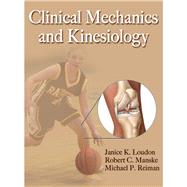Clinical Mechanics and Kinesiology
, by Loudon, Janice K., Ph.D.; Manske, Robert C.; Reiman, Michael P.- ISBN: 9780736086431 | 0736086439
- Cover: Hardcover
- Copyright: 3/15/2013
Clinical Mechanics and Kinesiology With Web Resourceprovides a solid foundation so that students of physical therapy, occupational therapy, and athletic training can understand biomechanics and functional anatomy as they relate to both normal and abnormal movement. Written by active clinicians with more than 40 combined years of clinical and teaching experience, this text is also a practical reference for rehabilitation professionals working with a range of populations and pathologies. Taking a clinical approach not found in other texts, Clinical Mechanics and Kinesiologyfollows a logical progression that maximizes learning. It first presents biomechanical principles that students must understand in order to examine and treat clients and patients undergoing rehabilitation. Next, it explores muscle and nerve physiology and function of the muscle and joint systems. Then the focus shifts to applying those concepts to specific joints. Divided into 10 regions, each joint is evaluated by the bones that make up the joints; the joint articulation, anatomy, and function; and the muscles that act on the joints. In the final section of the text, students gain insight into full-body movement patterns of particular concern to rehabilitation specialists. They will examine not only the usual topics of posture and walking gait but also running gait and the mechanics of jumping and cuttingsome of the most common sources of injury. Clinical Mechanics and Kinesiologyis enhanced with over 360 pieces of full-color art. Unique combination figures integrate detailed bone illustrations and photos. Medical art displays locations of bones, muscles, and ligaments. Arthrokinematic motions are clearly shown with the appropriate skeletal locations, making it easy for students to see how a particular motion relates to the rest of the body. Several other features also aid in students' learning and retention: A one-year subscription to Musculoskeletal Anatomy Review, an online anatomy program, provides an interactive forum for reviewing regional structural anatomy. Clinical Correlations included in each chapter help students increase their understanding of biomechanics and kinesiology and apply the theoretical content to clinical practice. Problem Sets and Practice It sidebars with activities in chapters 1 and 2 assist students in applying and mastering biomechanical concepts. Pedagogical aids such as chapter objectives and conclusions, key points, glossary terms, and review questions highlight important information so students can quickly grasp and review the main points. Included with each new text is a key code allowing students one-year access to the online anatomy program Musculoskeletal Anatomy Review. This engaging supplement offers a regional review of structural anatomy with exceptionally detailed, high-quality graphic imagesthe majority provided by Primal Pictures. Students can mouse over muscles and click for muscle identification. Each chapter features a pretest and posttest evaluation to help students pinpoint knowledge gaps and test their retention. Students may take the pretest multiple times (it is generated randomly so it will never be the same), but students may take the posttest only once. Test results can be printed and turned in, giving instructors the option to use the tests as a grading tool. In addition, instructors will have online access to an instructor guide, image bank, and test package. The instructor guide further encourages students' learning by offering class assignments and lab activities not featured in the book. The class assignments, at least three per chapter, are quick activities that can be completed in class. The lab activities are longer assignments intended to be completed outside the classroom by pairs of students. Each lab contains an overview, a statement of purpose, a list of equipment needed, and instruction on data collection and analysis. Written for students and practitioners of rehabilitation programs, Clinical Mechanics and Kinesiologyprovides a foundation in kinesiology reinforced by numerous clinically applicable examples. Students will gain a strong understanding of mechanical principles governing human motion, with particular knowledge of both normal and abnormal functional motions, and be able to apply their knowledge directly to rehabilitation protocols.






